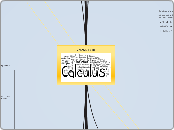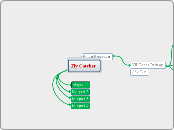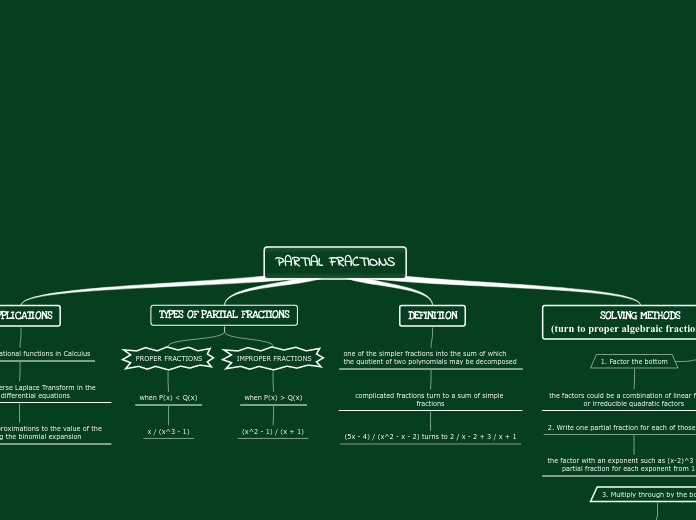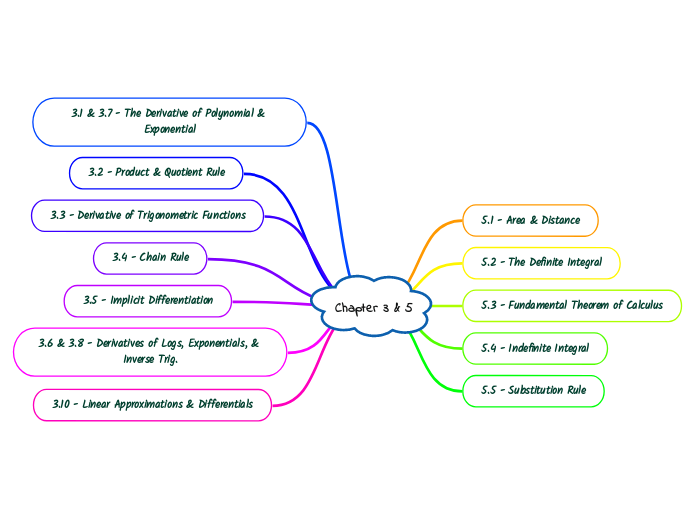VM266 1418
Parametrization
Derivative:
dy/dx = (dy/dt) / (dx/dt) if dx/dt not zero
d^2 y/ dx^2 = (dy'/dt) / (dx/dt)
Parametric Surface Area: x = f(t); y = g(t)
S = ʃ 2pi y ds = ʃ2pi g(t)[f'(t)^2 + g'(t)^2]^1/2 dt
About Y axis:
S = ʃ 2pi x ds = ʃ2pi f(t)[f'(t)^2 + g'(t)^2]^1/2 dt
Arc Length:
L = ʃ [f'(t)^2 + g'(t)^2]^1/2 dt
ds = [f'(t)^2 + g'(t)^2]^1/2 dt
Polar Coordinates
Polar Conics:
r = de/1+-ecosꝊ ; r = de/1+-esinꝊ
e = 1 => parabola
e > 1 => hyperbola
0 < e < 1 => ellipse and e=c/a
Integrals:
Area A = ʃ1/2 r^2 dꝊ
Arclength L = ʃ [r^2 + (dr/dꝊ)^2]^1/2 dꝊ
ds = [r^2 + (dr/dꝊ)^2]^1/2 dꝊ
Surface of Revolution about x axis S = ʃ2pi y ds
= ʃ2pi rsinꝊ [r^2 + (dr/dꝊ)^2]^1/2 dꝊ
About y axis S = ʃ2pi x ds
= ʃ2pi rcosꝊ [r^2 + (dr/dꝊ)^2]^1/2 dꝊ
x = rcosꝊ
y = rsinꝊ
r^2 = x^2 + y^2
tanꝊ = y/x if x not 0
slope m = dy/dx = (dy/dꝊ) / (dx/dꝊ)
= (dr/dꝊ * sinꝊ + rcosꝊ) / (dr/dꝊ * cosꝊ - rsinꝊ)
r = a is a circle
Ꝋ = a is a line
r = +- asinꝊ is a circle above/below the origin
r = +- acosꝊ is a circle right/left of the origin
r = a(1+-cosꝊ) is a cardioid right/left of the origin
r = a(1+-sinꝊ) is a cardiod above/below the origin
r = a+-bsinꝊ is a limacon right/left of origin
r = a+-bcosꝊ is a limacon above/below origin
r = asin nꝊ or r = acos nꝊ has 2n loops if n is even, n loops if n is odd
r = aꝊ is a spiral
Series and Sequences
Power Series
Theorem: For a power series ∑ck(x-x0)k, exactly one of the fallowing statements is true
a) The series converges only for x=x0
b) The series converges absolutely for all real values of x
c) Th series converges absolutely for all x in some finite open interval is (x0-R,x0+R) and diverges if xx0+R. At either of the values x=x0-R or x=x0+R, the series may converge absolutely, converge conditionally, or diverge, depending on the particular series.
Theorem: For any power series in x, exactly one of the following is true:
a) the series converges for x=o
b) the series converges absolutely for all real values of x
c) the series converges absolutely for all x in some finite open interval (-R,R) and diverges if x<-R or x>R. At either of the values x=R or x=-R, the series may converge absolutely, converge conditionally, or diverge depending on the particular series.
Convergence and divergence tests
Geometric series
ar^n-1
convergent if |r|<1, sum = a/1-r
divergent if |r|>=1
Root test
IF lim n->oo (An)^1/n = L, L < 1 Series An is abs. convergent. L > 1 || L = oo series is divergent. L = 1 inconclusive.
Ratio Test
limn→∞|an+1/an|=L:
(i) If L<1, then the series ∑an is absolutely convergent.
(ii) If L>1 or L=∞, then the series ∑an is divergent.
(iii) If L=1, inconclusive.
Test for Absolute Convergence
If the ∑|an| converges, then the ∑an absolutely converges.
Alternating Series test
(i) bn+1≤bn for all n
(ii) limn→∞bn=0
then the series is convergent.
Limit comparison
If limn→∞an/bn=c where 0
p-series
The p-series ∑1/np is convergent if p>1 and divergent if p≤1.
Integral test
(a) If ∫ƒ(x)dx is convergent, then ∑an is convergent.
(b) If ∫ƒ(x)dx is divergent, then ∑an is divergent.
Divergence test
If limn→∞an does not exist or if limn→∞an ≠ 0, then the series ∑an is divergent.
A sequence {a_n} has the limit L, or converges to L, if for every E>0 there exists a positive number N such that |a_n - L| < E whenever n>N
We say that limit = L
if we can make an as close to L as we want for all sufficiently large n. In other words, the value of the an’s approach L as n approaches infinity.
We say that limit = infinity
if we can make an as large as we want for all sufficiently large n. Again, in other words, the value of the an’s get larger and larger without bound as n approaches infinity.
We say that limit = negative infinity
if we can make an as large and negative as we want for all sufficiently large n. Again, in other words, the value of the an’s are negative and get larger and larger without bound as n approaches infinity.
A sequence is a function f whose domain is the set of positive integers.
Hyperbolic Functions
Definitions of Hyperbolic Functions:
sinh x = e^x - e^-x
2
cosh x = e^x + e^-x
2
tanh x = e^x - e^-x
e^x + e^-x
coth x = e^x + e^-x
e^x - e^-x
sech x = 2
e^x + e^-x
csch x = 2
e^x - e^-x
Integrals:
∫sinh u du = cosh u + C
∫cosh u du = sinh u + C
∫sech^2 u du = tanh u + C
∫csch^2 u du = -coth u + C
∫sech u tanh u du = -sech u + C
∫csch u coth u du = -csch u + C
Derivatives:
- Dx sinh u = cosh u Dx u
- Dx cosh u = sinh u Dx u
- Dx tanh u = sech^2 u Dx u
- Dx coth u = -csch^2 u Dx u
- Dx sech u = -sech u tanh u Dx u
- Dx csch u = -csch u coth u Dx u
Some properties:
cosh^2 x - sinh^2 x = 1
1 - tanh^2 x = sech^2 x
coth^2 x - 1 = csch^2 x
e^iθ = cosθ + i sinθ = cisθ
e^-iθ = cosθ - i sinθ = cisθ
cosh iθ = cosθ
sinh iθ = i sinθ
cos it = cosh t
cosh^2 t + sinh^2 t = cosh 2t
The Natural Logarithmic function
Definition:
ln x = ∫(1->x) 1/t dt if x≥1
-lx x = ∫(x->1) 1/t dt if 0
Laws of ln:
I - ln pq = ln p + ln q
II - ln p/q = ln p - ln q
III - ln p^r = r ln p for all rational r
How to read this map
Below is a list of how characters are used in this map:
_ after a variable indicates a subscript. i.e. x_1 means x subscript 1
^ indicates raising to a power. i.e. x^2 means x squared
Definite integrals are denoted ∫(a->b) x dx where a is the bottom number of the integral and b is the top
The Derivative
Notation:
f'(x) = D_x f(x) = D_x y = y' = dy/dx = d/dx f(x)
Hihger derivatives:
f''(x), f'''(x), f(⁴)(x),....,f^(n)(x)
D_x y, D²_x y,...,(D_x)^n y
d²y/dx², d³y/dx³,...,d^n y/dx^n
Techniques of differentiation:
- let n be an integer
- let c be a contstant
Note: proofs can be done by using the definition of the derivative
Power Rule:
if f(x) = cx^n, then f'(x) = cnx^(n-1)
I - Dx c = 0
II - Dx (mx + b) = m
III - Dx (x^n) = nx^(n-1)
IV - Dx [cf(x)] = c Dx f(x)
V - Dx [f(x) + g(x)] = Dx f(x) + Dx g(x)
VI - Dx [f(x) - g(x)] = Dx f(x) - Dx g(x)
VII - Dx f(x)g(x) = g(x)Dx f(x) + f(x)Dx g(x)
VIII - Dx [f(x)/g(x)] = g(x)Dx f(x) - f(x)Dx g(x)
[g(x)]^2
IX - Dx[1/g(x)] = -Dx g(x)
[g(x)]^2
Some notable derivatives:
- Dx sin x = cos x
- Dx cos x = -sin x
- Dx tan x = sec^2 x
- Dx cot x = -csc^2 x
- Dx sec x = sec x tan x
- Dx csc x = -csc x cot x
Vertical tangent lines:
The graph of a function f has a vertical tangent line x = a at the point P(a, f(a)) if f is continuous at at and if
lim |f'(x)| = ∞
x->a
A point P(a,f(a)) on the graph of a function f is a cusp if f is continuous at a and if the following two conditions hold:
I - f'(x) -> ∞ as x approaches a from one side
II - f'(x) -> -∞ as x approaches a from the other side
Determining differentiability:
A function f is differentiable on a closed interval [a,b] if f is differentiable on the open interval (a,b) and if the following limits exist:
lim f(a+h) - f(a) and lim f(b+h) - f(b)
h->0+ h h->0- h
If a function is differentiable at a, then f is continuous at a
Definition of the Derivative:
The slope m_a of the tangent line to the graph of the function f at P(a, f(a)) is
m_a = lim f(a+h) - f(a)
h->0 h
provided the limit exists.
The derivative of a function f is the function f′ defined by
f′(x) = lim f(a+h) - f(a)
h->0 h
provided the limit exists.
Because of the above two definitions, f′(x) = m_a
Alternate definition of the derivative:
f′(a) = lim f(x) - f(a)
x->a x - a
Some Theorems and statements
The fundamental Theorem of calculus:
(i) Assume that f(x) is continuous on [a,b] and differentiable on (a,b). Let F(x) be an antiderivative of f(x) on [a,b]. Then
b
ʃ f(x) dx = F(b) - F(a)
a
(ii) Assume f(x) is continuous on [a,b] and differentiable on (a,b).
x
Then the area function A(x) = ʃ f(t) dt is an antiderivative of f
a
That is A'(x) = f(x) or:
x
d/dx ʃ f(t) dt = f(x)
a
Furthermore, A(x) satisfies the initial condition A(a) = 0.
Extreme Values on a Closed Interval:
If f(x) is continuous on a closed interval [a,b], then f attains both a maximum and minimum value on [a,b]. Furthermore, if c in [a,b] and f(c) is an extreme value (min or max), then c is either a critical point or one of the endpoints, a or b.
Mean Value Theorem:
If f(x) is continuous on [a,b] and differentiable on (a,b), then there exists a value c in (a,b) such that f'(c) = f(b) - f(a) / b-a
Intermediate Value Theorem:
if f(x) is continuous on [a,b], then for every M between f(a) and f(b), there exists at least one value c in [a,b] such that f(c) = M
Rotation of Axes
x' = xcosꝊ + ysinꝊ
y' = -xsinꝊ + ycosꝊ
x = x'cosꝊ - y'sinꝊ
y = y'cosꝊ + x'sinꝊ
To eliminate xy term in Ax^2 + Bxy + Cy^2 + Dx + Ey + F :
pick Ꝋ such that cot2Ꝋ = (A-C)/B
0 < 2Ꝋ < pi
then use rotation of axes formulas above
Outline
Exponential Function
Some Properties:
lim (1+h)^1/h = e
h->0
lim (1+1/n)^n = e
n->∞
This seems to say that 1^∞ = e
Inverse Functions
Guidelines for finding f^-1 in simple cases:
1. Verify that f is a 1-1 function (or that it is increasing or decreasing) throughout its domain
2. Solve the equation y=f(x) for x in terms of y, obtaiing an equation of the form x = f^-1(y)
3. Verify the two conditions:
f^-1(f(x)) = x andf(f^-1(x)) = x
for every x in the domains of f anf f^-1, respectively.
Definition of an inverse function:
Let f be a 1-1 function with domain D and range R. A function g with domain R and range D is the inverse function of f, provided the following condition is true for every x in D and every y in R:
y = f(x) iff x = g(y)
If a differentiable function f has an inverse function g = f^-1 and if f'(g(c)) ≠ 0, then g is differentiable at c and
g'(c) = 1/f'(g(c))
This can be restated as follows:
If g is the inverse function of a differentiable function f and is f'(g(x)) ≠ 0, then
g'(x) = 1/f'(g(x))
Proof:
By the definition of the derivative:
g'(c) = lim g(x) - g(c)
x->c x - c
Let y = g(x) and a = g(c). Since f and g are inverse functions of each other,
g(x) = y <=> f(y) = x
g(c) = a <=> f(a) = c
since f is differentiable, it is continuous and hence, so is the inverse function g = f^-1. Thus, if x->c then g(x) -> g(c); that is, y->a. If y->a, then f(y) -> f(a). Thus, we may write
g'(c) = lim g(x) - g(c)
x->c x - c
= lim y - a
y->a f(y) - f(a)
= lim 1
y->a f(y) - f(a)
y - a
= 1
lim f(y) - f(a)
y->a y - a
= 1 = 1
f'(a) f'(g(c))
If f is continuous and increasing on [a,b], then f has an inverse function f^-1 that is continuous and increasing on
[f(a), f(b)].
Let g be an inverse of f. The domain of g is the range of f and the range of g is the domain of f.
A 1-1 function ha a unique inverse function
Proof:
assume g_1 and g_2 are inverse functions of f
by def. of inverse functions:
y=f(x) <=> x = g_1(y) for all x in D, for all y in R
y=f(x) <=> x = g_2(y) for all x in D, for all y in R
then g_1(y) = g_2(y) for all y in R
therefore: g_1 = g_2
The domain must be restricted when functions are not 1-1 to get an inverse
Proof:
Assume g is an inverse function of f
by the definition of an inverse function:
y = f(x) iff x = g(y)
for every x in D, for every y in R
I - x = g(y) = g(f(x))
II - y = f(x) = f(g(y))
Conversely, assume conditions I & II hold
Assume g is an inverse function of f
suppose y = f(x) for all x in D
from I - g(y) = g(f(x)) = x
therefore: y = f(x), for all x in D => x=g(y) for all y in R
conversely: x = g(y) for all y in R
from II - f(x) = f(g(y)) = y
therefore: x=g(y) for all y in R => y=f(x) for all x in D
Verification of g as an inverse:
Let f be a 1-1 function with domain D and range R. If g is a function with domain R and range D, then g is the inverse function of f iff both of the following conditions are true:
I - g(f(x)) = x for every x in D
II - f(g(y)) = y for every y in R
Definition of a one-to-one function:
A function f with domain D and range R is a one-to-one function if whenever:
- a ≠ b in D, then f(a) ≠ f(b) in R.
- f(a) = f(b) in R, then a = b in D
- for every y in R there exists a unique x in D such that f(x) = y
The horizontal line test is one way to check 1-1 graphically
Every increasing function is 1-1 because:
if a < b, then f(a) < f(b)
if b < a, then f(b) < f(a)
thus a ≠ b, then f(a) ≠ f(b)
Similarly, every decreasing function is 1-1
Trigonometry
Unit Circle
Integrals
∫ sin x dx = -cos x + c
∫cos x dx= sin x + c
∫ tan x dx=- ln cos x + c
∫sec 2 x dx=tan x + c
∫csc 2 x dx=- cot x + c
∫sec x tan x dx=sec x + c
∫csc x cot x dx=- csc x + c
∫ 1 / x dx=ln x + c
∫e x dx=e x + c
∫ 1 / √ (1 - x 2 ) dx=sin -1 x + c
∫ 1 / ( 1 + x 2 ) dx=tan -1 x + c
∫1/ x √ (x 2 -1) dx=sec -1 x + c
∫ sec x dx=ln [ sec x + tan x]
∫ csc x dx=- l [ csc x + cot x ]
Limits
Continuity:
A function is continuous at a number c iff:
I - f(c) is defined
II - lim f(x) exists
x->c
III - lim f(x) = f(c)
x->c
Let f be defined on [a,b]. f is continuous on [a,b] if it is continuous on (a,b) and if
lim f(x) = f(a) and lim f(x) = f(b)
x->a+ x->b-
If a function f is continuous and has no zeros on an interval, then either f(x) > 0 or f(x) < 0 for every x in the interval
If f and g are continuous at c, then the following are also continuous at c:
I - the sum of f+g
II - the difference f-g
III - the product fg
IV - the quotient f/g, provided g(c)≠0
A rational function q = f/g is continuous at every number except the numbers c such that g(c) = 0
Polynomials are continuous at every real number c
Techniques for finding limits:
I - lim [f(x) + g(x)] = lim f(x) + lim g(x)
x->a x->a x->a
II - lim [f(x) · g(x)] = lim f(x) · lim g(x)
x->a x->a x->a
III - lim [f(x)/g(x)] = lim f(x) / lim g(x)
x->a x->a x->a
IV - lim [c·f(x)] = c[lim f(x)]
x->a x->a
V - lim[f(x) - g(x)] = lim f(x) - lim g(x)
x->a x->a x->a
VI - lim [f(x)]^n = [lim f(x)]^n
x->a x->a
Intermediate Value Theorem:
if f is continuous on a closed interval [a,b] and if w is any number between f(a) and f(b), then there is at least one number c in [a,b] such that f(c) = w
lim f(x) = L iff lim f(x) = L = lim f(x)
x->a x->a- x->a+
if lim g(x) = b and if f is continuous at b, then
x->c
lim f(g(x)) = f(b) = f(lim g(x))
x->c x->c
If g is continuous at c and if f is continuous at b = g(c), then
I - lim f(g(x)) = f(lim g(x)) = f(g(c))
x->c x->c
II - the composite function f o g is continuous at c
Some special limits:
- lim (sin x)/x = 1
x->0
- lim (1 - cos x)/x = 0
x->0
- lim log x = ∞
x->∞
- lim log x = -∞
x->0+
- lim c/(x^k) = 0
x->±∞
for any pos rational number k
Sandwich/Squeeze Theorem:
Suppose f(x)≤h(x)≤g(x) for every xЄ of an open interval containing a, except possiblt at a.
If lim f(x) = L = lim g(x), then lim h(x) = L
x->a x->a x->a
Definition of the limit of a function:
Let a function f be defined on an open interval containing a, except possibly a itself, and let L be a real number. The statement
lim f(x) = L
x->a
means that for every ε > 0, there is a δ > 0 such that
if 0 < |x-a| < δ, then |f(x) - L| < ε
Limits involving infinity:
lim f(x) = L
x->∞
means that for every ε > 0, there is a number M > 0 such that
if x > M, then |f(x) - L| < ε
lim f(x) = L
x->-∞
means that for every ε > 0, there is a number N < 0 such that
if x < N, then |f(x) - L| < ε
lim f(x) = ∞
x->a
means that for every M > 0, there is a δ > 0 such that
if 0 < |x - a| < δ, then f(x) > M
Example:
Proove that lim (3x-5) = 7
x->4
let f(x) = 3x-5, a = 4, and L = 7.
if 0 < |x - 4| < δ, then |(3x-5) - 7| < ε
|(3x - 5) - 7| < ε
|3x - 12| < ε
|3(x - 4)| < ε
3|x - 4| < ε
|x - 4| < 1/3 ε
0 < |x-4| < δ
0 < |x-4| < 1/3ε
0 < 3|x-4| < ε
0 < |3x-12| < ε
0 < |(3x - 5) - 7| < ε
This verifies and completes the proof
Alternative definition of limit:
lim f(x) = L
x->a
means that for every ε > 0, there is a δ > 0 such that if x is in the open interval (a - δ, a + δ) and x ≠ a, then f(x) is in the open interval (L - ε, L + ε).









